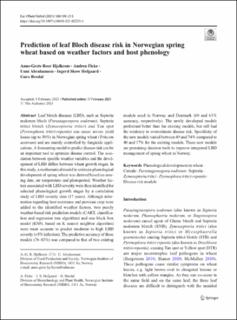| dc.contributor.author | Hjelkrem, Anne-Grete Roer | |
| dc.contributor.author | Ficke, Andrea | |
| dc.contributor.author | Abrahamsen, Unni | |
| dc.contributor.author | Hofgaard, Ingerd Skow | |
| dc.contributor.author | Brodal, Guro | |
| dc.date.accessioned | 2021-07-19T13:32:29Z | |
| dc.date.available | 2021-07-19T13:32:29Z | |
| dc.date.created | 2021-02-19T15:12:24Z | |
| dc.date.issued | 2021-02-17 | |
| dc.identifier.citation | European journal of plant pathology. 2021, 160 (1), 199-213. | en_US |
| dc.identifier.issn | 0929-1873 | |
| dc.identifier.uri | https://hdl.handle.net/11250/2764788 | |
| dc.description.abstract | Leaf blotch diseases (LBD), such as Septoria nodorum bloch (Parastagnospora nodorum), Septoria tritici blotch (Zymoseptoria tritici) and Tan spot (Pyrenophora tritici-repentis) can cause severe yield losses (up to 50%) in Norwegian spring wheat (Triticum aestivum) and are mainly controlled by fungicide applications. A forecasting model to predict disease risk can be an important tool to optimize disease control. The association between specific weather variables and the development of LBD differs between wheat growth stages. In this study, a mathematical model to estimate phenological development of spring wheat was derived based on sowing date, air temperature and photoperiod. Weather factors associated with LBD severity were then identified for selected phenological growth stages by a correlation study of LBD severity data (17 years). Although information regarding host resistance and previous crop were added to the identified weather factors, two purely weather-based risk prediction models (CART, classification and regression tree algorithm) and one black box model (KNN, based on K nearest neighbor algorithm) were most accurate to predict moderate to high LBD severity (>5% infection). The predictive accuracy of these models (76–83%) was compared to that of two existing models used in Norway and Denmark (60 and 61% accuracy, respectively). The newly developed models performed better than the existing models, but still had the tendency to overestimate disease risk. Specificity of the new models varied between 49 and 74% compared to 40 and 37% for the existing models. These new models are promising decision tools to improve integrated LBD management of spring wheat in Norway. | en_US |
| dc.language.iso | eng | en_US |
| dc.publisher | Springer | en_US |
| dc.rights | Navngivelse 4.0 Internasjonal | * |
| dc.rights.uri | http://creativecommons.org/licenses/by/4.0/deed.no | * |
| dc.title | Prediction of leaf Bloch disease risk in Norwegian spring wheat based on weather factors and host phenology | en_US |
| dc.type | Peer reviewed | en_US |
| dc.type | Journal article | en_US |
| dc.description.version | publishedVersion | en_US |
| dc.rights.holder | © The Author(s) 2021 | en_US |
| dc.source.pagenumber | 199-213 | en_US |
| dc.source.volume | 160 | en_US |
| dc.source.journal | European journal of plant pathology | en_US |
| dc.source.issue | 1 | en_US |
| dc.identifier.doi | 10.1007/s10658-021-02235-6 | |
| dc.identifier.cristin | 1891860 | |
| dc.relation.project | Norges forskningsråd: 244526 | en_US |
| cristin.ispublished | true | |
| cristin.fulltext | original | |
| cristin.qualitycode | 1 | |

